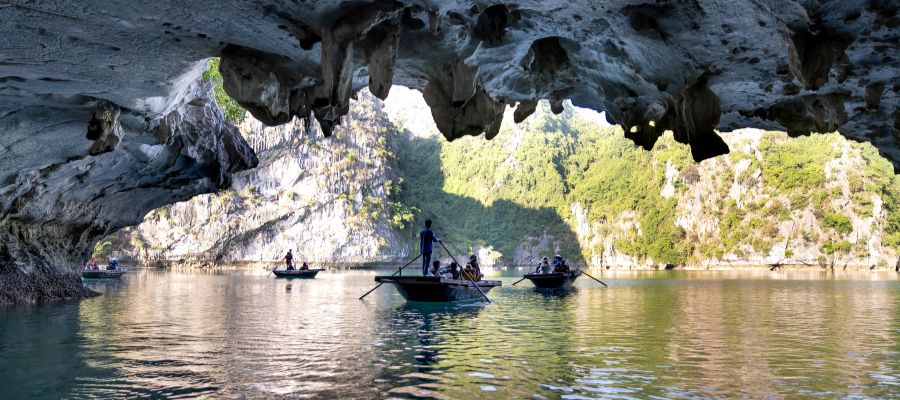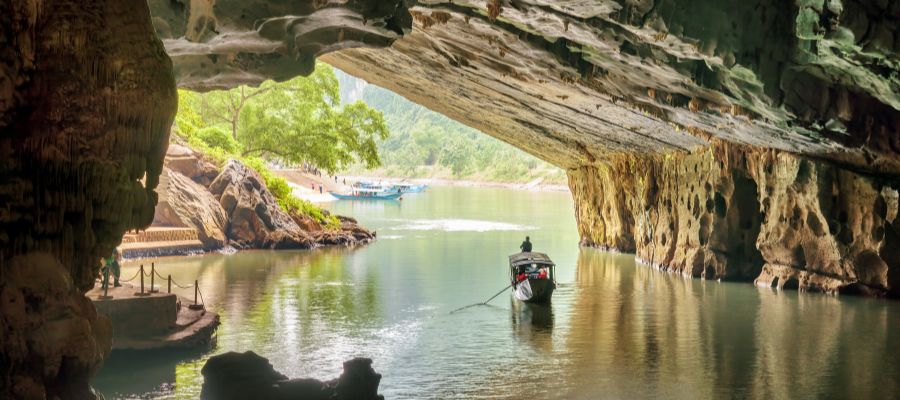Vietnam’s Intriguing Caves: An Underground Adventure
Vietnam is home to some of the most breathtaking caves in the world, boasting incredible geological formations, underground rivers and lakes, and unique ecosystems. From the massive Son Doong Cave, the world’s largest cave, to the stunning stalactites and stalagmites of Paradise Cave, these underground wonders are a must-see for any adventurous traveler.

With a rich history dating back thousands of years and fascinating legends attached to many of them, exploring these caves is like embarking on a journey through time. Join us on an underground adventure as we delve into the history and features of Vietnam’s intriguing caves.
History Of The Caves In Vietnam
Vietnam is home to beautiful caves with a rich history dating back thousands of years. Prehistoric civilizations used them for shelter, storage, and religious purposes. Archaeological excavations have uncovered human occupation dating back to the Stone Age.
Today, many caves in Vietnam are popular tourist attractions, admired for their natural beauty and cultural significance. Phong Nha’s stalactites and stalagmites and Marble Mountain’s hidden Buddhist temples are just a few examples of the country’s stunning geological and cultural heritage.
Top 5 Famous Caves In Vietnam
1. Son Doong Cave
Son Doong Cave, located in Vietnam’s Quang Binh Province, is a stunning natural wonder discovered in 2009 by a local. It opened to the public in 2013 and has since become a popular destination for adventurers and nature lovers. The cave is more than five kilometers long, with chambers reaching 200 meters high and contains its own ecosystems with unique structures like stalactites, stalagmites, and subterranean rivers.
A visit to the cave is a four-day trek through deep forest and rugged terrain, requiring visitors to be in good physical condition. The cave is not only a geological wonderland, but also an important scientific discovery shedding light on the earth’s geological processes and climate change. Son Doong Cave is a must-see for explorers, nature enthusiasts, and scientists due to its vastness, unique formations, and enigmatic underground environment.
2. Paradise Cave
Paradise Cave is a stunning natural beauty in Quang Binh province, Vietnam. Discovered in 2005, it is famous for its magnificent stalactite and stalagmite formations created over millions of years. The tunnel is Asia’s largest dry cave, spanning over 31 kilometers, but only around 1 kilometer is accessible to tourists.
The interior is a masterpiece of geological formations with calcite deposits and crystal formations. A visit to Paradise Cave offers a chance to experience Mother Nature’s natural splendor and immerse yourself in the mysteries of the underground world. The lighting system adds to the enchantment, creating a dreamlike ambiance.
3. Phong Nha Cave
Phong Nha Cave in Quang Binh province is a must-see for visitors to Vietnam. With a length of over 7 kilometers, it boasts captivating limestone karsts, subterranean rivers, and grand cave chambers. Its intricate and distinctive formations, including stalactites and stalagmites, are formed by water over millions of years.

Visitors can take a boat ride down the Son River to reach the cave’s entrance and explore its spectacular chambers. Phong Nha Cave is part of the Phong Nha-Ke Bang National Park, a UNESCO World Heritage Site, and is one of the world’s most extraordinary cave systems.
4. Sung Sot Cave
Sung Sot Cave, located on Bo Hon Island in Halong Bay, is a popular tourist destination. The cave, discovered by the French in 1901, is nicknamed the “cave of surprises” due to its stunning beauty. Visitors can explore the ½ km long, 30m high cave with two caverns, filled with natural sculptures formed by stalactites and stalagmites that resemble various objects and lifeforms.
It involves walking up and down rugged steps, sometimes in darkness, so wear comfortable shoes with good grips and take a poncho. The cave is quite popular, so expect crowds and keep your belongings safe. Opening hours are 08:00-18:00, and ticket prices are usually included in tours or around $4 at the counter.
5. Luon Cave
Luon Cave is a stunning natural wonder in the heart of Halong Bay, Vietnam. Visitors can reach the cave by boat and explore it in tiny wooden boats rowed by locals. The cave features amazing rock formations and crystal-clear waters with a diverse range of aquatic species.
Visitors can also learn about local culture from boatmen who guide them through the tunnel. Luon Cave is a must-see attraction for anyone visiting Halong Bay, with its breathtaking beauty and rich cultural heritage.
Fauna And Flora
Fauna and flora refer to the animal and plant life in a particular region. Vietnam is home to a diverse range of flora and fauna, with thousands of species found throughout the country.
The country’s forests and wetlands are home to many rare and endangered species, including the Indochinese tiger, Asian elephant, and clouded leopard. The rich biodiversity of Vietnam is also home to many unique plant species, such as the Vietnamese golden cypress and orchids.
Responsible Tourism And The Beautiful Caves Of Vietnam
Vietnam is home to some of the world’s most stunning caves, including the famous Son Doong Cave and the Phong Nha Cave System. However, with an increase in tourism, there are growing concerns about the impact on the natural environment and the delicate ecosystems within these caves.
To ensure responsible tourism, visitors are encouraged to follow the guidelines provided by local authorities, such as staying on designated paths, not touching or removing any formations, and not littering. Tour companies are also urged to operate sustainably by reducing waste, using eco-friendly products, and supporting local communities.
In addition to responsible tourism practices, efforts are being made to protect the flora and fauna within these caves. For example, the Phong Nha-Ke Bang National Park, which includes the Phong Nha Cave System, is home to many rare and endangered species, such as the Saola and the Truong Son muntjac. Conservation efforts are being made to protect these species and their habitats, including the implementation of stricter regulations and monitoring of human activities in the area.
By promoting responsible tourism and protecting the delicate ecosystems within these beautiful caves, visitors can continue to enjoy the natural wonders of Vietnam while ensuring their preservation for future generations.
16 responses to “Vietnam’s Intriguing Caves: An Underground Adventure”
Recent Posts
Other Info
- Turkey Visas for Tourism, Business Purposes
- Apply for Turkish Student Visa
- Turkey Work Visa or Work Permit
- Turkey Transit Visa
- Turkey Residence Permit
- Turkish Visa
- E Visa of Turkey
- Visa for Turkey US Citizen
- Turkey Visa for Pakistani
- Electronic Visa Turkey
- Turkey Travel Visa
- Visa on Arrival Turkey
- US Citizen Travel to Turkey
- Chinese Embassy Turkey
- Visa for Turkey From Canada
- Visa Required for Turkey
- Visa Transit Turkey
- Turkey Transit Visa for US Citizens
- Form for Entry to Turkey
- Turkey Visa for US
- Visa Requirements for Turkish Citizens
- Need Urgent Turkey Visa?
- Turkey Visa Information
- Turkey Essential Guidelines for U.S. Citizens
- US Visa for Turkey
- Passport for Turkey
- Turkey Visa Online
- Turkey Visa for Indian
- Turkish Visit Visa
- Visa Application Form Turkey
- E Visa Turkey Cost
- Tourist Visa to Turkey
- Visa Application to Turkey
- Apply Visa to Turkey
- Traveling to Turkey From Canada
- Getting a Visa for Turkey
- Visa Cost Turkey
- Kenya E Visa
- eVisa Kenya Online
- Kenya Online Visa
- Kenya e-Visa
- Kenya Entry Requirements
- Kenya Visa Requirements for US Citizens
- Kenya Visa for US Citizens
- Vaccines For Kenya
- Yellow Fever Vaccine Kenya
- Yellow Fever Certificate Kenya
- Vaccinations Required For Kenya
- Kenya Transit Visa
- Kenya Multiple Entry Visa
- Kenya Business Visa
- Kenya E Visa Fees
- Kenya eVisa Cost
- Kenya evisa Application
- Kenya Online Visa Application
- Kenya evisa Processing Time
- Kenya Visa on Arrival
To start applying online click on 'Apply Now' Button
лордфильм фильмы
лордфильм
лордфильм
you have a great blog here! would you like to make some invite posts on my blog?
lordfilm сериалы
русская порнуха
секс видео
секс видео
I will right away grasp your rss feed as I can not find your email subscription link or newsletter service. Do you have any? Please let me recognize so that I could subscribe. Thanks.
смотреть онлайн
порно видео
порно видео
порно
онлайн порно
Real instructive and fantastic anatomical structure of content material, now that’s user genial (:.
порно